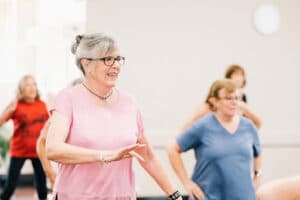
Senior living isn’t what it used to be. The days of purely clinical care environments are giving way to holistic communities that emphasize well-being, fulfillment, and self-expression.
Across the country, senior living providers are recognizing that health isn’t just about medical stability – it’s about confidence, connection, and quality of life.
From yoga studios to med-spa-style amenities, wellness and aesthetic services are reshaping how residents experience aging. These offerings are about dignity, empowerment, and helping older adults feel like their best selves at every stage of life.
The Shift Toward Whole-Person Wellness
Today’s senior living communities are moving beyond traditional healthcare models. Residents expect (and deserve) more than routine checkups or medication management. They want experiences that nourish the body, mind, and spirit.
Fitness centers, meditation rooms, nutrition programs, and massage therapy are becoming standard features in high-quality communities.
These offerings recognize that maintaining independence and vitality requires more than physical health. They provide residents with a sense of purpose and joy, allowing them to stay active and engaged in meaningful ways.
At the same time, communities are beginning to integrate aesthetic and spa-style services – from facials to light therapy – as part of broader wellness programming. These are key to holistic well-being, encouraging residents to take pride in their appearance and feel comfortable in their skin.
Confidence, Dignity, and Self-Expression in Aging
Feeling good about how we look has a powerful effect on self-esteem. This is especially true for older adults navigating visible signs of aging. Communities that offer opportunities for grooming, skincare, or restorative aesthetic treatments empower residents to take ownership of their appearance and well-being.
Maintaining a polished appearance isn’t superficial – it supports emotional resilience. Investing in self-care has a direct impact on maintaining self-esteem and confidence, as well as mental health and overall quality of life.
When residents can style their hair, enjoy a manicure, or experience rejuvenating skincare, they’re reminded that aging gracefully is as much about confidence as it is about care.
Many senior living centers now employ on-site stylists, aestheticians, and even visiting dermatologists to provide these services safely and conveniently. This integration of wellness and beauty reflects a cultural shift: aging is not about retreating from self-expression but embracing it in new ways.
The Rise of On-Site Aesthetic Services
A growing number of senior living communities are incorporating med-spa or aesthetic-style facilities within their campuses. These range from simple skincare rooms to full-service rejuvenation studios offering treatments like LED therapy, microdermabrasion, and non-invasive facial contouring.
The introduction of advanced, safe aesthetic equipment makes this transition possible. Communities and wellness centers are consulting resources, such as aesthetic clinic equipment buying guides, to ensure they select devices that are gentle, compliant, and suitable for older skin.
Treatments focused on hydration, collagen stimulation, and circulation not only enhance appearance but can also support skin health, which is particularly important for seniors prone to dryness or sensitivity.
This new era of on-site aesthetics aligns with preventive healthcare models. By addressing physical appearance alongside health and mobility, communities support residents in maintaining confidence and independence.
Personalized Wellness Programs for Every Resident
No two aging journeys are alike, and today’s communities are adapting by creating individualized wellness and aesthetic plans. Residents can choose from yoga classes, massage therapy, nutrition counseling, skincare sessions, and mindfulness programs tailored to their personal goals.
Some communities pair wellness coaches with residents to assess not just medical needs, but lifestyle and emotional well-being. For example, one resident may thrive in a Pilates class designed to strengthen balance, while another might prefer meditation and aromatherapy to manage anxiety.
Integrating aesthetic care into these programs (such as soothing facials or hand treatments) ensures that self-care feels inclusive and accessible to everyone, not just a select few.
Inclusive Design and Accessibility in Wellness Spaces
Accessibility is central to making wellness services meaningful for all residents. An inclusive healthcare approach ensures facilities are physically and emotionally welcoming to people of all mobility levels, genders, and cultural backgrounds.
In practice, this means creating spaces that are barrier-free and thoughtfully designed — spa rooms with adjustable treatment chairs, handrails in fitness areas, and lighting that feels calming but bright enough for safety.
Staff training also plays a major role. When caregivers and technicians understand older adults’ unique physical and emotional needs, they can deliver care that feels empowering rather than clinical.
Inclusive design is more than architecture; it’s a mindset that ensures everyone has access to experiences that make them feel seen, valued, and cared for.
Technology’s Role in the Future of Senior Wellness
Technology is driving many of these advancements. Wearable health devices now track sleep, activity, and hydration levels, while digital wellness apps guide meditation and stretching routines.
Some communities use virtual reality for memory care therapy or virtual fitness classes to keep residents engaged even from their apartments.
In the aesthetic realm, innovations in non-invasive treatments, from LED therapy panels to gentle microcurrent facials, allow older adults to enjoy rejuvenation without discomfort or risk.
These advances are helping redefine aging, proving that wellness and self-care can continue to evolve with us at every stage of life.
As communities invest in these tools, the future of senior living looks brighter, more personalized, and deeply human-centered.